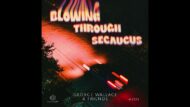 Audio Project: Blowing Through Secaucus
Audio Project: Blowing Through Secaucus
George Wallace and Friends
(available on streaming platforms)
drawn from Poetry Collection Blowing Through Secaucus
George Wallace
Gutter Snob Books
Reviewer: Shawn Pavey
You think New Jersey, you think wise guys. It just happens. George Wallace knows this. He’s going to tell you about them. In fact, he’s going to set the whole thing to music.
In Blowing Thru Secaucus, we see Wallace in his best form slinging lines like the jazz that drives his rhythms. These poems are rich in music and sparse on punctuation, relying, instead, on the language to punctuate itself, to paraphrase Gertrude Stein (and you can tell Wallace has read Stein). In the opening poem, “johnny on the pavement,” Wallace introduces us to his conversational yet concise syncopation:
it was st pattie’s day somebody
said hey herbie hancock is in
englewood cliffs & that was big
so we showed up at
the backdoor of the studio
to pay our respects
but just missed him
because of a little trouble at the mobil station
Like jazz, Wallace’s language breathes and spits: longer, sweeping lines punctuated by short, staccato phrases. Think Miles Davis’s Sketches of Spain, Dizzy Gillespie’s Birk’s Works; for Wallace, jazz is bebop the way it was for the Beats who owed their immediacy and sound equally to Walt Whitman and Charlie Parker. Is Wallace a neo-Beat or a holdover from that era? Who cares. When a poem bounces with this much energy, we believe Wallace when he intones “that’s what america’s made of / a lot of jazz.” The poem continues through the raucous young night like all good tales of daring do – bending, twisting, throwing in the surprise (it’s always cops, right?) to conclude:
yeah
that was the night
herbie hancock
recorded maiden voyage
in englewood cliffs
we were part of history
I remember it well
Throughout this collection, Wallace rolls down the windows on that long, pre-gas crisis street cruiser and speeds off through his neighborhoods of memory. This hits the eye and the ear in the way the best of Jim Carroll impacts. There’s a lingering hint of The Basketball Diaries and Catholic Boy to these poems. It could be the rhythms, it could be a holdover from my multiple listens to the album and all those NY/NJ accents, but the road these poems travels is heading in the same place Carroll traveled. Carroll was more closely rooted in ’60s garage rock and ’70s protopunk than jazz, but Carroll and Wallace strike immediately, draw you in, don’t waste time on back story unless a note or two drops into the narrative for context. These poems of memory bring the reader to that distant yet still vibrant now.
There’s no time wasted on nostalgia, that’s not what these poems are about. These poems tell the stories of the hyper urban life from just outside the border of the photos in NY/Newark tourism brochures. Take “rain beats down on route 22,” for instance:
new year’s eve, rain beat
down on route 22, yes it
was like that in the 1980s
an unholy decade, suicides
& shoddy analysis, some went
broke some went punk some
had tight pants and hair out to
here some sat at home & watched
the nj nets go 24-58 but we
liked to hang out at the bar & get
stupid with beer, lit up like a
xmas tree, monarchs among
men – fucking new jersey …
This is a snapshot, the subjects a bit blurred from movement, painting the immediacy of a chance encounter with a woman lost on her way to Springsteen and needing directions to the Meadowlands. So we hear the story, but the poem emerges in “the first honest ray of sunshine” as Wallace gives the reader not just the event and not just the conversation but also painting the backdrop with the control of a Wyeth and the liberty of Basquiat.
The poem “retribution blues” is a great segue to the album from George Wallace and Friends. In a chat with Wallace about this project and how it came together, he stated that he financed the whole project, but let others do the heavy lifting – a bass player with fat fingers, a piano player who can do anything, a drummer with some brushes, a crack engineer, etc., and fronted the studio time. He sat in a Jimmy Webb seat sipping Pepsi as the pros knocked each piece out in around 20 minutes.
But this doesn’t sound rushed. Blowing Thru Secaucus by George Wallace and Friends is available on various streamer platforms, but I’d recommend a high quality headphone listen with a favorite relaxant on hand and through a service with reasonably good sound quality. The musicians are tight, the rhythms swing, the voices match the cadence. What’s interesting is that Wallace’s own voice is only on two tracks, but it’s hard to mistake him as anyone but the author. He lives in these poems like skin. It’s obvious to the ear. On “retribution blues,” the music opens with a tasty blues lick and settles into a familiar, “House of the Rising Sun”-type blues chord progression as Anthony Policano chants:
this poem for the gym rat
this poem for the high roller
this poem for the slick cat
this poem for the stalker
this poem for the wife beater
the secret racist the man
in the camouflage pants
this poem for the bully
the bigmouth & the my way
or the highway guy
this poem for the bandy legged
football coach who couldn’t
get it up & has been bullying
16 year-old boys for 20-
something years better
stay home tonight, boys
here comes little miss payback
angel of justice fairness
& harmony wearing
stiletto & chains
smoking dimestore
cigarettes packing
the retribution blues
gonna be fireworks tonight &
we are not talking grucci
no not the innocent kind
The jazz delivery plays off the slow blues background and melds into an audio experience that is immediately satisfying. Neither the music nor the language bore – each track takes a new turn but all on a familiar path. The cuts vary from a wire-brush percussion shuffle to honky-tonk piano fun. The poems entertain, the music does not disappoint.
Get the book and hold it. Listen to the music and turn it up a bit. Pour something tasty and settle in.

